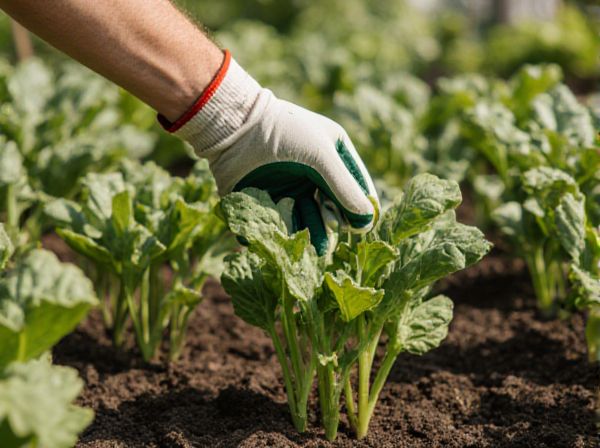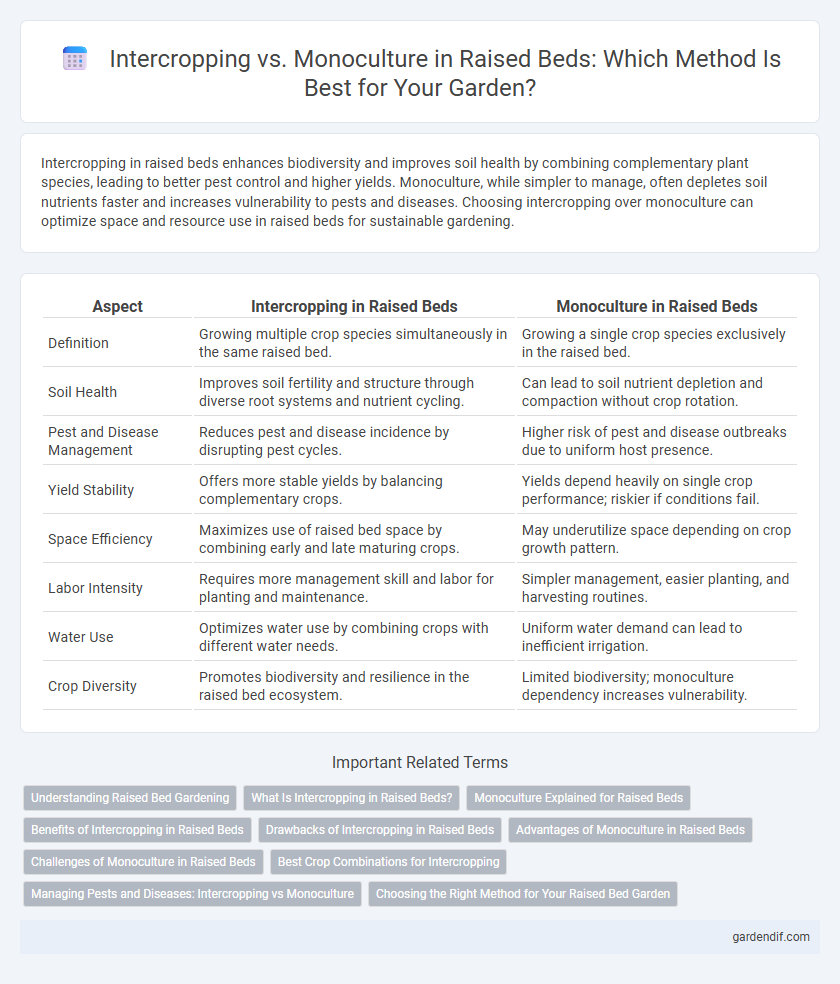
Intercropping vs Monoculture in raised beds Illustration
Intercropping in raised beds enhances biodiversity and improves soil health by combining complementary plant species, leading to better pest control and higher yields. Monoculture, while simpler to manage, often depletes soil nutrients faster and increases vulnerability to pests and diseases. Choosing intercropping over monoculture can optimize space and resource use in raised beds for sustainable gardening.
Table of Comparison
| Aspect | Intercropping in Raised Beds | Monoculture in Raised Beds |
|---|---|---|
| Definition | Growing multiple crop species simultaneously in the same raised bed. | Growing a single crop species exclusively in the raised bed. |
| Soil Health | Improves soil fertility and structure through diverse root systems and nutrient cycling. | Can lead to soil nutrient depletion and compaction without crop rotation. |
| Pest and Disease Management | Reduces pest and disease incidence by disrupting pest cycles. | Higher risk of pest and disease outbreaks due to uniform host presence. |
| Yield Stability | Offers more stable yields by balancing complementary crops. | Yields depend heavily on single crop performance; riskier if conditions fail. |
| Space Efficiency | Maximizes use of raised bed space by combining early and late maturing crops. | May underutilize space depending on crop growth pattern. |
| Labor Intensity | Requires more management skill and labor for planting and maintenance. | Simpler management, easier planting, and harvesting routines. |
| Water Use | Optimizes water use by combining crops with different water needs. | Uniform water demand can lead to inefficient irrigation. |
| Crop Diversity | Promotes biodiversity and resilience in the raised bed ecosystem. | Limited biodiversity; monoculture dependency increases vulnerability. |
Understanding Raised Bed Gardening
Intercropping in raised bed gardening enhances soil fertility and pest control by growing complementary plants together, maximizing limited space and resources efficiently. In contrast, monoculture involves cultivating a single crop, which can lead to nutrient depletion and increased vulnerability to pests and diseases. Understanding these methods helps gardeners optimize raised bed productivity and promote sustainable growth.
What Is Intercropping in Raised Beds?
Intercropping in raised beds involves growing two or more complementary crops simultaneously in the same space, maximizing plant diversity and resource use efficiency. This practice enhances soil health, reduces pest outbreaks, and increases overall yield by optimizing light, nutrients, and water distribution. Unlike monoculture, which cultivates a single crop, intercropping promotes ecological balance and sustainable gardening in confined raised bed environments.
Monoculture Explained for Raised Beds
Monoculture in raised beds involves cultivating a single crop species in a defined area, optimizing space and resource allocation for that specific plant. This method simplifies planting, maintenance, and harvesting while allowing tailored soil amendments to meet the crop's nutritional needs. However, monoculture can increase vulnerability to pests and diseases compared to intercropping systems in raised bed gardening.
Benefits of Intercropping in Raised Beds
Intercropping in raised beds enhances biodiversity, leading to improved pest control and reduced disease incidence compared to monoculture. It optimizes space utilization by growing complementary crops together, increasing overall yield per square foot. Nutrient cycling improves as different plants contribute varied root structures and nutrient demands, promoting soil health and fertility.
Drawbacks of Intercropping in Raised Beds
Intercropping in raised beds can lead to competition for nutrients, water, and sunlight among different plant species, reducing overall growth efficiency. Managing pests and diseases becomes more complex due to the diverse plant types, increasing the risk of infestations spreading rapidly. Space constraints in raised beds often limit the optimal spacing required for each crop, potentially reducing yield compared to monoculture systems.
Advantages of Monoculture in Raised Beds
Monoculture in raised beds simplifies crop management by allowing growers to tailor soil amendments, watering, and pest control precisely to a single plant species' needs. This focused approach can enhance crop uniformity and yield predictability, making it easier to mechanize tasks such as planting and harvesting. Moreover, monoculture reduces competition for nutrients and sunlight within the bed, optimizing resource allocation for the chosen crop.
Challenges of Monoculture in Raised Beds
Monoculture in raised beds often leads to nutrient depletion and increased vulnerability to pests and diseases due to the lack of plant diversity. This practice can cause soil degradation and reduced crop yields over time, as the same crop repeatedly extracts specific nutrients. Limited biodiversity also diminishes beneficial insect populations, complicating pest control and requiring more chemical interventions.
Best Crop Combinations for Intercropping
Intercropping in raised beds enhances soil health and maximizes space by combining complementary crops such as tomatoes with basil, or carrots with onions, which repel pests and improve growth. Contrastingly, monoculture focuses on a single crop but often leads to nutrient depletion and higher pest vulnerability. Selecting the best crop combinations for intercropping, like legumes with leafy greens, optimizes nutrient cycling and boosts yield efficiency in raised bed gardening.
Managing Pests and Diseases: Intercropping vs Monoculture
Intercropping in raised beds significantly enhances pest and disease management by increasing biodiversity, which disrupts pest life cycles and reduces the spread of diseases compared to monoculture systems. Diverse plant species in intercropping create physical barriers and attract beneficial insects, leading to natural pest control and healthier soil microbiomes. Monoculture raised beds often suffer from increased vulnerability to specific pests and pathogens due to uniform crop susceptibility and lack of ecological balance.
Choosing the Right Method for Your Raised Bed Garden
Intercropping in raised beds enhances biodiversity and maximizes space by planting complementary crops that improve soil nutrients and reduce pests naturally. Monoculture simplifies management and focuses on a single crop, which can increase yield but may deplete soil nutrients faster and raise vulnerability to diseases. Selecting the right method depends on your garden goals, available space, and crop resilience, with intercropping suited for sustainability and monoculture for intensive production.
Intercropping vs Monoculture in raised beds Infographic

 gardendif.com
gardendif.com